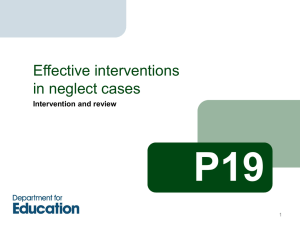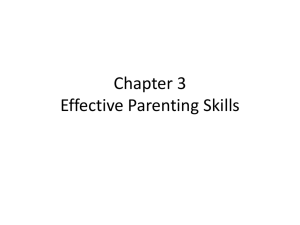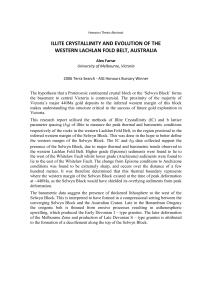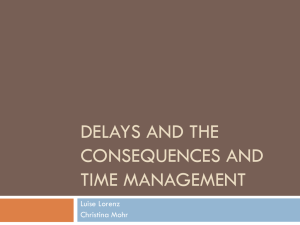The Impact and Avoidance of Delay in Decision Making
advertisement
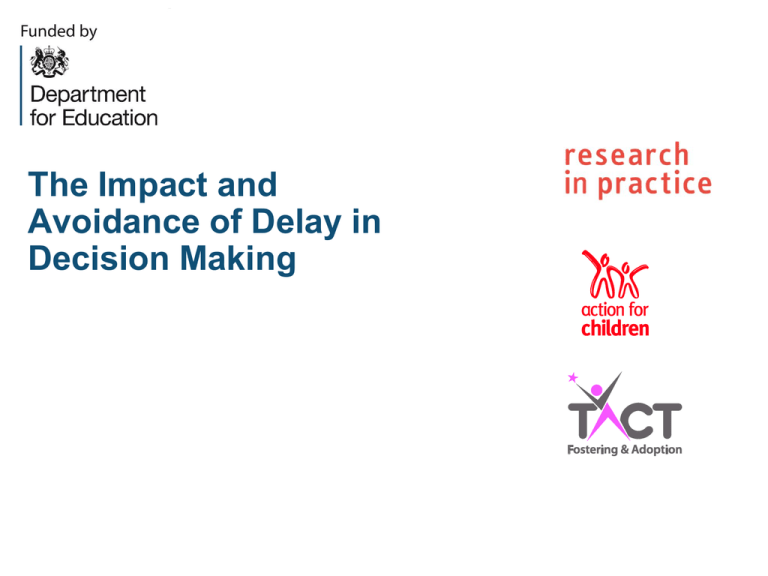
The Impact and Avoidance of Delay in Decision Making Impact of Abuse and Neglect Lack of decisive action in tackling abuse and neglect can have an impact on all aspects of children's development The longer a child is left inadequately protected the greater the chance that their long-term wellbeing will be compromised Abuse and neglect in the early years can lead to problems in the following areas over the course of childhood: • • • • • • • • • • attachment and ability to trust others ability to empathise ability to regulate emotions education outcomes delinquency mental and physical health promiscuity eating disorders addictive behaviours parenting capacity Children Left Too Long in Unsafe Environments (1) Ward et al (2012)- follow-up study of infants identified before their first birthday as at risk of suffering significant harm Children spent lengthy periods in an abusive environment while assessments were made of parenting capacity and progress On average, it took fourteen months for a definitive decision to be made, and six more months for the plan to be activated Children Left Too Long in Unsafe Environments (2) Farmer and Lutman (2010)- five year follow up study of children who had been neglected Half of the children had been referred before they were two years old Three fifths of referrals did not lead to decisive often because there was no ‘trigger incident’ Selwyn et al (2006)- children remained at home for 2.7 years before being taken into care In many cases, the children were still being abused and neglected while they were still living with their families. Case Management Delayed decision making during care proceedings means that children have to live with uncertainty and insecurity Longer proceedings can reduce chances of permanency A shortage of suitable placements leads to decisions to place children in care being put off until there is a crisis Social workers often under pressure to find a placementchild's needs often downplayed and placements poorly matched and more likely to be disrupted The move to a more permanent placement is often delayed once the pressure is relaxed Double Jeopardy Children permanently separated often experienced 'double jeopardy'. The children spend lengthy periods in an abusive environment This is followed by a short period of stability with an interim carer The child then suffers a disrupted attachment when they move out of the temporary placement and enter a permanent placement These children showed the most severe developmental and behavioural difficulties by the time they were three years old, and these persisted as they entered formal education (Ward et al, 2012) Delayed Decision Making and Adoption Delayed decision making can have an adverse effect on children’s chances of being adopted The chances of being adopted reduce by nearly a half for every year of delay (Selwyn et al, 2006) Age at joining a new family is the variable that has the most impact on adoption outcomes (Boddy, 2013) Dance et al (2010) found that there were delays in matching children with adoptive families because of poor planning and inadequate case management including a lack of proactive case work delays in exploring inter-agency adoptions slowness is assessing potential adopters and rigidity in family search Reasons for Delay Delays can occur at all stages of care proceedings- many are outside the control of social workers Pre-proceedings stage- delay through poor planning and reactive rather than proactive case management Local authority legal departments can also delay decisions to instigate proceedings During court proceedings- most common cause of delay are • • • • the late ordering and completion of reports waiting for the results of assessments repeated assessments of parenting capacity consecutive assessment of relatives Other causes of delay • • expectation that children able to remain with birth parents, despite evidence to suggest the opposite thresholds for access to children's social care set too high Reducing Delayed Decision Making Careful and quick assessment focusing on whether it is safe for the child to stay in their current circumstances Careful planning- where planning is weak, there is evidence of drift so that children are left too long in abusive circumstances Challenging unacceptable parental behaviours- having time-limited written agreements with parents setting out the consequences for noncompliance Where parents do not have the capacity to overcome adverse behaviour patterns, placement in local authority care is generally more beneficial for maltreated children than remaining at home or returning home following a period in care (Wade et al, 2010; Farmer and Lutman, 2010) Social workers need to develop a trusting and meaningful relationship with children and families to help them deal with their anxieties and the uncertainty where there are delays in a permanence decision being made Videoclips Decision Making Within a Child's Timeframe
